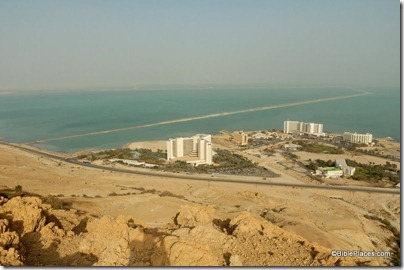Today’s Haaretz carries a blistering article on the failure of the Israeli government to act on the rising level of the southern half of the Dead Sea. While the northern half is dropping, the southern portion threatens to flood six hotels near the shoreline.
Short-term thinking. Unthinking optimism – “everything will work out.” Putting off hard decisions, selling national assets for peanuts, and first and foremost, of course, a lack of governance. These are the factors behind the ecological monster that is the Dead Sea, which is about to flood the hotels built in the Ein Bokek oasis.
After one High Court ruling, two biting reports by the state comptroller and any number of warnings about the gravity of the situation, the government is supposed to finally make decisions. It has to decide how to rescue one of Israel’s most important tourism destinations, the lowest place on earth. After 20 years of foot-dragging, it has to decide how best to stop the rising level of the sea’s southern half from swamping the hotels.
[…]
Israel’s ignoring of nature was the root of the evil behind the damaging of the Dead Sea. Israel built its main water conduit from north to south in the 1950s. At the time this was hailed as progress; only later came recognition of the tremendous damage it caused. Since the national conduit redirected water to central Israel, it all but eliminated the flow of natural water down the Jordan River south of Lake Kinneret. Israel’s neighbors Syria and Jordan diverted the course of the Jordan and Yarmouk rivers too. The upshot was that during the 20th century, the Dead Sea fell 25 meters.
Also to blame for the drop in sea level is the Dead Sea Works, owned by Israel Chemicals (ICL ), which in turn is owned by the Ofer family. DSW is responsible for 20% of the drop in sea level, according the Geological Institute. It siphons seawater into evaporation pans south of the sea, from which it extracts the potash it sells worldwide as fertilizer.
[…]
It came up with three suggestions. One: Harvest the salt building up on the floor of the pool to keep the water level steady. Two: Create a lagoon by splitting the salt pool into two parts. The water level of the part by the hotels would remain steady. Three: Raze the six hotels on the shore (and the adjacent shopping centers ) and rebuild them elsewhere.
The Tourism Ministry is deliberating between option one (harvest ) and three (move ), and is reportedly leaning toward the latter. The Finance Ministry (which doesn’t get to decide ) supports the last option, as the cheapest.
This is not the first time this subject has been addressed in the media, but this may be the best article to date. Read the whole for more details.
